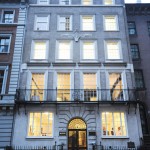Gentrification has become a buzz word when discussing urban geography, sociology, and political science. Although the idea of gentrification — broadly defined as the renovation of a deteriorated area by middle or upper class peoples that displace poorer residents — is pretty straight forward, I want to identify and define a more fully fleshed out working conception.
In Endogenous Gentrification and Housing Price Dynamics, researchers Guerrieri, Hartley, and Hurst describe a model that connects gentrification directly to housing prices. The term ‘endogenous gentrification’ refers to the process in which higher income residents out bid poorer residents when there is a housing demand boom and optimal locations become too expensive or otherwise sub-prime. What results is a spillover of monetarily well-endowed migrants relocating to prime community-adjacent neighborhoods, which systematically spreads the effects of gentrification.
The researchers present evidence that shows how gentrification sprawls out from developed and re-developed communities. They also show that during periods of housing price appreciation overall, low-income communities have even higher rates of housing appreciation and gentrification. Hurt goes on to suggest that “in 70 years there will not be many poor people living in New York.”
Manhattan’s Chelsea neighborhood is an excellent example of such forms of gentrification. Flanked by the trendy and very expensive West Village neighborhood, spill over into Chelsea begun when artists were priced out and moved north. Urban greening, like the High Line has accelerated gentrification, and has now caused such inflation in rental prices that the art galleries that moved here decades ago are being priced out to Brooklyn (although gentrification has also caused Brooklyn to become increasingly cost-prohibitive).
The High Line, a defunct above-ground railway turned park/walkway in New York City – initially seen by many as a positive community investment — is the main reason for this rapid gentrification in Chelsea. After years of campaigning on behalf of community organizers and celebrity activists to repurpose the dilapidated tracks, the Bloomberg administration pledged $43 million towards park construction in 2004, lifting the High Line from pipe dream to possibility.
Although the park is mere blocks away from multiple large public housing complexes, it quickly became clear that it was not built for them. Instead, the high line was built for the millions of tourists it attracts annually, as well as the millionaires who will live above its greenery. What the High Line has brought to the pre-2005 residents is an ever expanding food desert and loss of local employment opportunities.
How did this all happen? In the year following Bloomberg’s pledge, the city planning office announced a zoning change directly adjacent to the proposed High Line to accommodate high rise commercial and residential buildings. This zoning change taints the money the Bloomberg administration offered for the project and leaves a taste of government-funded gentrification on the palate. As seen in the figure below, the Elliot-Chelsea and Fulton Houses counter the $100,000 + annual income of the surrounding area drastically.
As construction began on the High Line, developers raced to raise luxury apartment buildings. The increasing property values associated with the new amenities and residents wreaked havoc on both the residents and businesses in the area. Prior to construction of the High Line, automotive repair businesses and restaurants that catered to locals dotted 10th avenue and the adjacent blocks. Now, only the curbside oil stains remain. The NYCEDC noted the precipitous rise in median markets value per square foot in Chelsea, finding that within a 5 minute walking distance of the High Line, there was a 103% increase in market value between 2003 to 2011.
Inequality now runs rampant in post-High Line Chelsea. In the NYU Furman Center report State of New York City’s Housing and Neighborhood in 2014, Chelsea is ranked third in income diversity in New York City. Although diversity is usually coded as a positive, in Chelsea’s context this really means there is a wildly rapid demographical change occurring. With over 30% of Chelsea’s residents making less than $20,000 annually, the rise in property prices and cost of living is crippling them. The model below describes the changes in income brackets in Chelsea with a time frame of about 10 years. The lowest bin of income earners is expanding, and so is the top bin, which clearly points to a divided community.
Another report ordered by the NYC Center for Economic Opportunity and written by Abt Associates, further examined the relationship between changing neighborhoods and New York City Housing Authority Residents:
“Chelsea has undergone tremendous changes in the last few decades. The neighborhood has seen dramatically rising incomes and NYCHA residents perceive it has become more of a destination for outsiders than a place that caters to their needs. Many local establishments, like laundromats and corner delis, that made the neighborhood feel affordable and comfortable for NYCHA residents have closed; even new affordable housing is out of reach to residents we interviewed, making NYCHA housing the only viable option for them in the area. Many NYCHA residents appreciate some of the changes but do not feel fully integrated into the changing community; for example, they sometimes feel disturbed by crowds of tourists or uncertain with respect to patronizing new establishments.”
This feeling of isolation and alienation is tangible in Chelsea. Although public housing residents are not directly hurt by rising property values, as their own housing costs are not increasing at the same rate, they certainly are impacted by the types of businesses that now line the streets. Apple stores have replaced affordable grocery stores, and laundromats have now become exotic coffee roasters. And although Chelsea Market is overflowing with food, very little of it is affordable. A low-cost food desert has been created.
Without proper zoning laws and government programs, the history of Chelsea will be reduced to the brief blurb that is labeled on the High Line signs.








